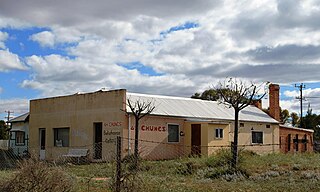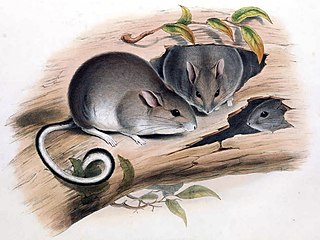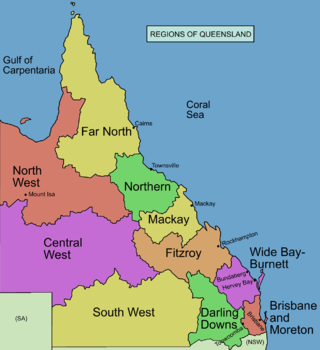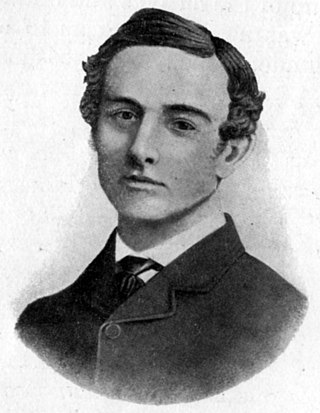Related Research Articles

The Burke and Wills expedition was organised by the Royal Society of Victoria in Australia in 1860–61. It consisted of 19 men led by Robert O'Hara Burke and William John Wills. Its objective was the crossing Australia from Melbourne in the south to the Gulf of Carpentaria in the north, a distance of around 3,250 kilometres. At that time most of the inland of Australia had not been explored by non-Indigenous people and was largely unknown to the European settlers.

Menindee is a small town in the far west of New South Wales, Australia, in Central Darling Shire, on the banks of the Darling River, with a sign-posted population of 980 and a 2016 census population of 551. Menindee was the first town to be established on the Darling River. There are two distinct theories for the derivation of the township’s name: (a) from the Barkindji word "minandichi" for the shallow ephemeral lake north-west of the present-day township; (b) from the Barkindji word 'milhthaka', meaning "yolk of an egg".

The white-footed rabbit rat is an extinct species of rodent, which was originally found in woodlands from Adelaide to Sydney, but became restricted to south-eastern Australia. It was kitten-sized and was one of Australia's largest native rodents. It was nocturnal and lived among trees. It made nests filled with leaves and possibly grass in the limbs of hollow eucalyptus trees. The mother carried her young attached to her teats. In a letter to John Gould, then Governor of South Australia Sir George Grey said that he removed a baby from a teat of its dead mother. The baby clung tightly to Gould's glove.

William John Wills was a British surveyor who also trained as a surgeon. Wills achieved fame as the second-in-command of the ill-fated Burke and Wills expedition, which was the first expedition to cross Australia from south to north, finding a route across the continent from the settled areas of Victoria to the Gulf of Carpentaria.

Innamincka, formerly Hopetoun, is a township and locality in north-east South Australia with a population of 44 people as of the 2016 census. By air it is 820 kilometres north-east of the state capital, Adelaide, and 365 kilometres north-east of the closest town, Lyndhurst. It is 66 kilometres north-east of the Moomba Gas Refinery. The town lies within the Innamincka Regional Reserve and is surrounded by the Strzelecki Desert to the south and the Sturt Stony Desert to the north. It is linked by road to Lyndhurst via the Strzelecki Track, to the Birdsville Developmental Road via Cordillo Downs Road and Arrabury Road, and the Walkers Crossing Track to the Birdsville Track. The Walkers Crossing Track is closed in summer and only traversable in dry weather. The township is situated along the Cooper Creek, a part of the Lake Eyre basin.

William Landsborough was an explorer of Australia and notably he was the first explorer to complete a North-to-South crossing of Australia. He was a member of the Queensland Legislative Council.
The Ngarabal are an Aboriginal people of the area from Ashford, Tenterfield and Glen Innes in northern New South Wales, Australia.

South West Queensland is a remote region in the Australian state of Queensland which covers 319,808 km2 (123,479 sq mi). The region lies to the south of Central West Queensland and west of the Darling Downs and includes the Maranoa district and parts of the Channel Country. The area is noted for its cattle grazing, cotton farming, opal mining and oil and gas deposits.

Edwin James Welch was an English naval cadet, surveyor, photographer, newspaper proprietor, writer and journalist. Welch discovered John King, sole survivor of the Burke and Wills expedition.

European land exploration of Australia deals with the opening up of the interior of Australia to European settlement which occurred gradually throughout the colonial period, 1788–1900. A number of these explorers are very well known, such as Burke and Wills who are well known for their failed attempt to cross the interior of Australia, as well as Hamilton Hume and Charles Sturt.

Burke and Wills Camp B/CXIX is a heritage-listed campsite at Burke and Wills Access Road, Normanton, Shire of Carpentaria, Queensland, Australia. It is also known as Walker's Camp. It was added to the Queensland Heritage Register on 14 August 2008.
Dr Ludwig Becker's Grave is a heritage-listed grave at Molesworth Station, by the Bulloo River, Bulloo Downs, Shire of Bulloo, Queensland, Australia. He was buried in 1861. It was added to the Queensland Heritage Register on 5 August 1994.

The Dig Tree is a heritage-listed, blazed, eucalyptus tree at Nappa Merrie Station, Durham, Shire of Bulloo, Queensland, Australia. It was blazed on 21 April 1861. It was added to the Queensland Heritage Register on 28 February 2003.
The Yandruwandha, alternatively known as Jandruwanta, are an Aboriginal Australian people living in the Lakes area of South Australia, south of Cooper Creek and west of the Wangkumara people.
Noonthorangee located at 30°57′50″S 142°17′53″ is a remote civil parish of Mootwingee County in far North West New South Wales.
Yandaminta Creek is an ephemeral stream in Far West New South Wales that flows from near Milparinka to the South Australian border where it enters Lake Boolka. It location is at 30.03333 ° S 141.01667 ° E. Yandaminta Creek starts at an elevation of 216m and drops around 128m over its 159 km length entering the lake at an elevation of 88.4m.
Myles Archibald Lyons was a Mounted Police Trooper stationed at Swan Hill, Victoria. He was on the Burke and Wills expedition from the Murray River to Coopers Creek, in September 1860.
Alexander MacPherson was on the Burke and Wills expedition support expedition from the Murray River to Coopers Creek, in September 1860.

The Burke, Wills, King and Yandruwandha National Heritage Place is a heritage-listed historic precinct on the Birdsville Track, Innamincka, South Australia, Australia. It was added to the Australian National Heritage List on 22 January 2016.

Dr. Hermann Beckler was a German doctor with an interest in botany. He went to Australia to collect specimen for Ferdinand von Mueller and served as medical officer and botanist for the Victoria Exploring Expedition in 1860.
References
- ↑ Peter FitzSimons, Burke and Wills (Hachette Australia) page 282.
- ↑ Portrait of Dick, 21 December 1860.
- ↑ Ian Clark, Fred Cahir, The Aboriginal Story of Burke and Wills: Forgotten Narratives (CSIRO Publishing, 2013) page 7.
- ↑ Ian Clark, Fred Cahir, The Aboriginal Story of Burke and Wills: Forgotten Narratives (CSIRO Publishing, 2013) page 70.
- ↑ Hermann Beckler, edited by Stephen Jefferies, A Journey To Cooper's Creek (Carlton, Vic., Melbourne University Press, 1993).
- ↑ Peter FitzSimons, Burke and Wills (Hachette Australia )
- ↑ Ian Clark, Fred Cahir, The Aboriginal Story of Burke and Wills: Forgotten Narratives (CSIRO Publishing, 2013) page 7.
- ↑ Dig, the Burke and Wills Research Gateway.
- ↑ Ian Clark, Fred Cahir, The Aboriginal Story of Burke and Wills: Forgotten Narratives (CSIRO Publishing, 2013) page 107.
- ↑ Telegrams and Chequebook The Burke and wills Research Gateway.